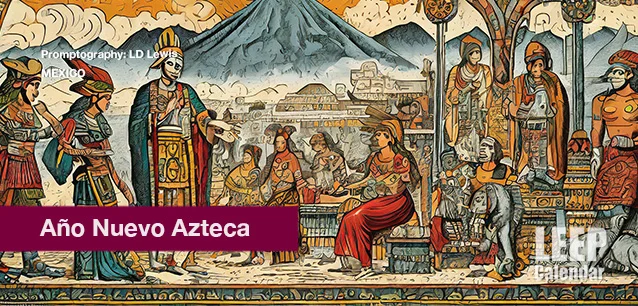 AD
AD
Today is: November 24
Scroll to explore events active on this date.
Additional Events on LEEP
LEEP INK FEATURES

August is Appropos
A toddler playing in the fountain at a park in Santa Fe, New Mexico—Photo LD Lewis. In August, we live through the Dog Days of Summer. It's hot and often humid, and those ...

September is Sassy
Can you hear that sigh of relief from parents worldwide? Yes! September marks the return of students to school, a global phenomenon. Preparations for the ACT and SATs begin earnestly for ...

OOH LA LA, October
October is the busiest month for events, with 5% more happening than in May, the second most eventful month. Sailing enthusiasts will be glued to the finals of this year's Am...
About Año Nuevo Azteca in Mexico
Mexico & Central America
Ends: Mar 12, 2024
DESCRIPTION:
Año Nuevo Azteca in Mexico:
Celebrating the Aztec Calendar's Rich Heritage
Año Nuevo Azteca, or Aztec New Year, is an observance in Mexico that honors the ancient Aztec calendar, a central element of Aztec culture and history. The day celebrates the rich cultural heritage influencing Mexican society and indigenous communities.
The Aztec calendar, a sophisticated and intricate system, was central to the Aztec civilization, which flourished in central Mexico in the 14th to 16th centuries. This calendar was not just a tool for measuring time but also a framework for religious and social rituals deeply embedded in the cosmology and mythology of the Aztec people.
The Aztec calendar first appeared during the sixth century and draws heavily on multiple Mesoamerican cultures. It consisted of two overlapping cycles: the 260-day Tonalpohualli, used for divination and determining the timing of religious and cultural events, and the 365-day Xiuhpohualli, which measured the solar year.
The Tonalpohualli often called the sacred or ritual calendar, was divided into 20 periods of 13 days. Each period was associated with specific deities and cosmological elements, making it a vital tool for priests in forecasting auspicious or inauspicious days for various activities. The Xiuhpohualli was similar to the solar year in the Gregorian calendar but was divided into 18 months of 20 days, plus a short month of five days called nemontemi, considered unlucky.
The Aztec calendar differs significantly from the Gregorian calendar, today's standard system. The Gregorian calendar, introduced in 1582 by Pope Gregory XIII, is a solar calendar based on the Earth's revolutions around the Sun and is primarily secular in its application. In contrast, the Aztec calendar was profoundly religious and symbolic, interweaving mythological and astronomical cycles.
Various cultural and educational events, including traditional dances, ceremonies, and lectures on the Aztec civilization, mark Año Nuevo Azteca. This observance allows Mexicans, especially those with indigenous ancestry, to reconnect with and honor their ancestral heritage. It also serves as an educational moment for the broader public to learn about the complexity and sophistication of the Aztec civilization and its contributions to history and culture.
Año Nuevo Azteca in Mexico celebrates the ancient Aztec calendar, a symbol of the Aztec civilization's rich cultural and historical tapestry. This observance highlights the enduring influence of indigenous cultures in Mexico and serves as a reminder of the country's diverse and multifaceted heritage.
VIDEOS
SUPPORTING DOCUMENTS
Currently, this event does not have supporting documents.
ADDITIONAL IMAGES
Currently, this event does not have supporting images.
Where would you like to go now?
 AD
AD


/footer-logo.svg)
